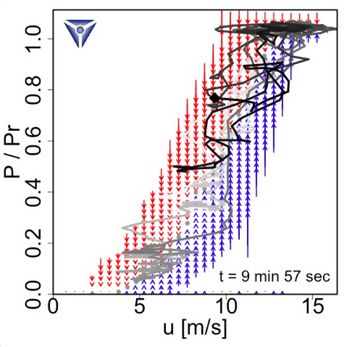The turbulent character of wind energy
Contact

Prof. Dr. Joachim Peinke
Institute of Physics
Phone: 0441/798-3536
E-Mail:
peinke uni-oldenburg.de
uni-oldenburg.de
The turbulent character of wind energy
The turbulent character of wind energy
While in previous studies it has been shown that intermittency in atmospheric turbulence is transferred to the electrical power output of wind turbines, new results suggest that wind turbulence has an even greater impact on electrical power grids. Patrick Milan und Matthias Wächter from the team of physicist Prof. Joachim Peinke at the University of Oldenburg, Germany, have characterized the dynamics of wind energy conversion by analyzing measurement data of an operating wind farm. As a central result, the typical intermittent properties of wind showed evidence to persist on the large scales of an entire wind farm. Moreover, this intermittency is even increased by the nonlinear conversion process when fed as electrical power into the grid. These results emphasize the significance of better understanding the physics of turbulence in order to ensure stability of future electrical grids.
In their recent article in Physical Review Letters the researchers explain that on small time scales such as seconds the energy conversion process follows complex patterns including multifractal scaling, in accordance with Kolmogorov's theory of turbulence of 1962.
"Looking at an operating wind turbine, one may get the impression that the turbine turns smoothly, but looking at the power output, which is the consequence of the forces and torques inside the machinery, we see that the fluctuations are very turbulent," Peinke points out. "Changes of MW (more than one thousand horsepower) in seconds become obvious. Thus one may compare a wind turbine with an airplane in the landing phase during a very windy situation. From outside, the airplane may look it's going quite smoothly, but inside there is another impression caused by turbulent dynamics. One should also note that a wind turbine has to operate permanently in this 'turbulent landing' condition."

Dynamics of a modern wind turbine's electrical power output on a one-second scale. The background shows the deterministic drift field of a reconstructed Langevin equation for the power conversion dynamics.
Moreover, the results show that wind power intermittency also extends to entire wind farms, which has not been observed before. This wind farm intermittency is rather counterintuitive, as it might be expected that the turbulent fluctuations of different turbines average out. Long-range correlations, typically observed in winds, offer an explanation for this effect. These have been found to extend to lengths of hundreds of kilometers.
The physicists conclude that their results stress the importance of accounting for the intermittent and multifractal nature of wind power when designing wind power systems and their grid integration.
"For all of these topics, a deep and comprehensive understanding of the complexity of turbulence is indispensable," Peinke said.
[25.04.2013]


